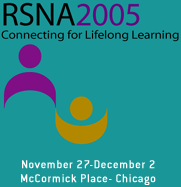
Abstract Archives of the RSNA, 2005
SSE01-02
Correlation between the Mammographic Findings and HER-2 Gene Overexpression in Breast Cancers
Scientific Papers
Presented on November 28, 2005
Presented as part of SSE01: Breast (Mammography)
Bo Kyoung Seo MD,PhD, Presenter: Nothing to Disclose
Etta D. Pisano MD, Abstract Co-Author: Nothing to Disclose
Cherie Marie Kuzmiak DO, Abstract Co-Author: Nothing to Disclose
Marcia Koomen MD, Abstract Co-Author: Nothing to Disclose
Elodia B. Cole MS, Abstract Co-Author: Nothing to Disclose
Juneyoung Lee PHD, Abstract Co-Author: Nothing to Disclose
Yeonhee Lee MD, Abstract Co-Author: Nothing to Disclose
Dag Pavic MD, Abstract Co-Author: Nothing to Disclose
et al, Abstract Co-Author: Nothing to Disclose
To compare mammographic findings in breast cancers based on the status of HER-2 overexpression, and correlate them with clinical and pathological findings.
The institutional review board at the University of North Carolina, Chapel Hill approved this study. From 2001 to 2003, 543 pathologically confirmed breast cancers were included. Two tests were used for evaluation of HER-2 status, immunohistochemistry and fluorescence in situ hybridization with breast specimen. We evaluated any differences in age distribution, parenchymal patterns on mammography, abnormal findings on mammography, and tumor types and grades on pathologic examination between breast cancers with and without HER-2 overexpression.
Younger women with less than 50 years had more frequent HER-2 overexpression than women with 60 - 69 years (p 0.05). In the masses on mammography, calcifications as an associated finding were more common in cancers with HER-2 overexpression (p < 0.05). Linear morphology was more frequent in cancers with HER-2 overexpression (p < 0.05). On pathology, invasive ductal carcinoma and comedo ductal carcinoma in situ were more frequent among cancers with HER-2 overexpression, and invasive lobular carcinoma and cribriform ductal carcinoma in situ were more common among cancers without HER-2 overexpression (p < 0.05). HER-2 overexpression was more common in high grade invasive cancers and ductal carcinoma in situ (p < 0.05).
Overexpression of HER-2 is strong correlation with age, morphology of calcifications on mammography, and tumor subtypes and grades on pathology.
Seo, B,
Pisano, E,
Kuzmiak, C,
Koomen, M,
Cole, E,
Lee, J,
Lee, Y,
Pavic, D,
et al, ,
Correlation between the Mammographic Findings and HER-2 Gene Overexpression in Breast Cancers. Radiological Society of North America 2005 Scientific Assembly and Annual Meeting, November 27 - December 2, 2005 ,Chicago IL.
http://archive.rsna.org/2005/4415692.html

